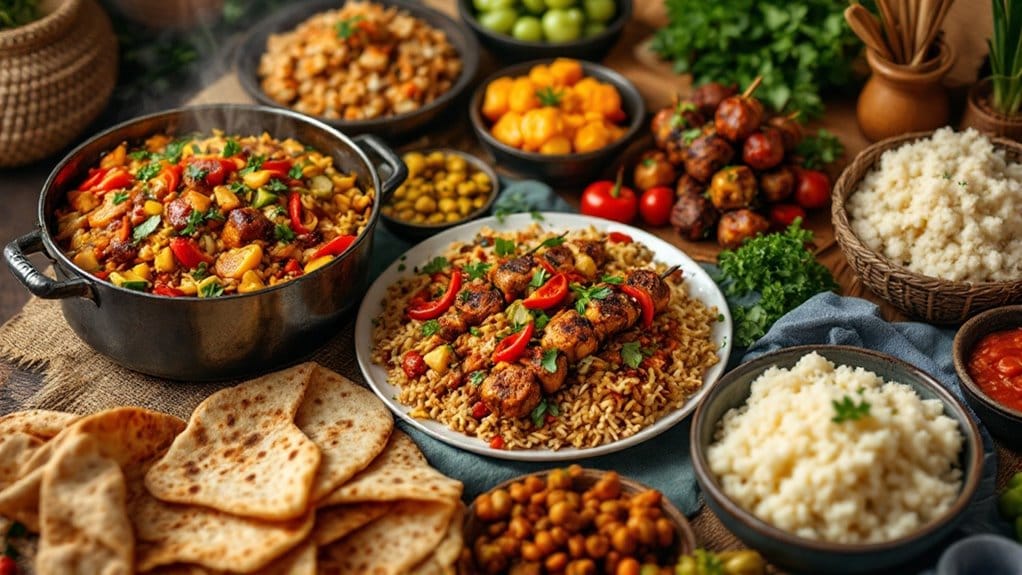Africa's culinary heritage is a vibrant mix of flavors, ingredients, and traditions that tell rich stories of its diverse cultures. You'll find staple grains like millet and sorghum forming the base of many meals, while unique spices create bold flavors in dishes such as jollof rice and injera. Cooking techniques, like communal braai and one-pot stews, promote bonding and reflect regional influences. These meals aren't just about sustenance; they embody historical connections and celebrate community ties. Discover how these elements weave together to define a continent's culinary identity, and you'll uncover even more fascinating insights.
Key Takeaways
- Africa's culinary heritage is rooted in ancient agricultural practices, with staples like millet, sorghum, and cassava reflecting regional identities.
- Traditional meals often celebrate community bonds and cultural identity, featuring dishes like jollof rice and injera, passed down through generations.
- Diverse regional influences shape African cuisine, with unique spices and cooking techniques creating distinct flavors across different cultures.
- Food serves as a medium for cultural expression, preserving historical narratives and reinforcing social ties through shared meals and celebrations.
- Challenges such as food insecurity highlight the importance of sustainable agricultural practices to ensure the continuity of culinary traditions and heritage.
Historical Roots of African Cuisine
The historical roots of African cuisine are rich and diverse, dating back to the Bronze Age in Northeast Africa when early communities began cultivating barley and wheat. These agricultural practices laid the groundwork for the vibrant culinary traditions we cherish today.
As you explore African cuisine, you'll discover how ancient Egyptians practiced settled agriculture, domesticating animals and creating a foundation for future culinary delights.
The accounts of Arab explorers like Leo Africanus and Ibn Battuta highlight the varied and rich food practices across the continent. Traditional African dishes often center around staple foods such as millet, sorghum, and cassava, all of which have been passed down through generations.
Over time, diverse culinary influences emerged, especially during the 19th century when European colonization introduced new staples like maize and potatoes. This exchange forever altered traditional diets, creating a fusion of flavors that continues to evolve.
As you savor African cuisine, you're not just tasting food; you're connecting with a history that spans millennia, celebrating the resilience and creativity of communities who've shaped these beloved culinary traditions.
Regional Culinary Variations
Exploring Africa's regional culinary variations reveals a tapestry of flavors and techniques that reflect the continent's diverse cultures and histories.
Each region offers a unique culinary experience, inviting you to savor its distinctive dishes. Here's what you might discover:
- West African: Immerse yourself in the bold spices of Jollof rice, where rice meets rich flavors, often enhanced by historical trade influences.
- Central African: Enjoy hearty meals with cassava and yams, where fufu-like staples perfectly accompany grilled meats and stews.
- East African: Relish dishes like ugali, a maize porridge, and seafood from the Swahili coast, highlighting a blend of indigenous and Middle Eastern influences.
- Southern African: Experience the "rainbow cuisine," where ingredients and techniques reflect a rich cultural heritage through dishes like pap and biltong.
These regional variations create a sense of belonging, connecting you to the broader African culinary identity.
As you explore these diverse dishes, you'll not only taste history but also feel the heartbeat of communities that have shaped these remarkable flavors.
Each bite is more than just a meal; it's a connection to Africa's vibrant past and present.
Key Ingredients and Flavors
While you explore Africa's culinary landscape, you'll quickly discover that key ingredients and flavors are essential to understanding its rich diversity. Staple grains like rice, millet, sorghum, and teff form the backbone of many meals, providing the carbohydrates that fuel everyday life.
Legumes, such as lentils, chickpeas, and beans, are indispensable, offering protein and fiber that enrich stews and side dishes, connecting you to the wisdom of African ancestors who cultivated these crucial resources.
Fresh vegetables and fruits—think okra, eggplant, and watermelon—bring vibrant colors and essential nutrients to your plate, enhancing both flavor and health. You'll also encounter unique spices and seasonings, like berbere, ras el hanout, and suya, which elevate African dishes with their complexity and depth.
Each bite tells a story, weaving together the culinary heritage of diverse cultures that have thrived across the continent.
As you savor these ingredients, you'll not only taste the essence of Africa but also feel a connection to its rich traditions and shared history. Embrace this adventure, and let the flavors guide you through Africa's culinary tapestry.
Traditional Cooking Techniques
In many African kitchens, traditional cooking techniques play an essential role in bringing dishes to life. These methods not only preserve age-old practices but also foster a sense of community and belonging.
You'll often find people gathering around an open fire, sharing stories and laughter while preparing meals together. Here are some key techniques that define this culinary heritage:
- One-pot cooking: Combining grains, vegetables, and meats into flavorful stews or porridge creates warmth and connection.
- Fermentation: Techniques like those used for injera in Ethiopia enrich dishes, adding depth and character.
- Open-fire cooking: The communal braai, especially popular in South African culture, transforms meals into celebrations.
- Traditional tools: The use of clay pots and wooden utensils enhances the unique flavors that make each dish special.
These traditional cooking techniques not only showcase the diversity of African cuisine but also highlight the importance of food in bringing people together.
Embracing these practices allows you to connect with the heart of Africa's culinary heritage, creating unique dishes that resonate with love and tradition.
Cultural Significance of Meals
When you think about African meals, you see how they shape cultural identity and bring people together.
Celebratory dishes like jollof rice and injera aren't just food; they represent heritage and shared memories.
Food as Cultural Identity
Meals in Africa often serve as a powerful reflection of cultural identity, with dishes like jollof rice and injera not just feeding bodies but also nourishing traditions. When you gather around a table, you're not just sharing food; you're sharing history, stories, and a sense of belonging.
Traditional African meals encapsulate the essence of community celebrations and highlight the unique culinary techniques passed down through generations.
Here are a few ways food shapes cultural identity:
- Connection to Heritage: Each dish tells a story of your ancestors and their way of life.
- Celebration of Togetherness: Communal eating reinforces bonds, reminding you that you're part of something bigger.
- Expression of Belonging: Sharing meals allows you to connect with others, fostering a sense of unity.
- Reflection of Local Practices: Ingredients like cassava and maize showcase regional agricultural traditions that shape your cultural landscape.
In every meal you prepare and share, you're not just feeding yourself; you're weaving the fabric of your cultural identity and celebrating the rich tapestries of African heritage.
Celebratory Meal Traditions
Celebratory meals in Africa serve as vibrant expressions of community and tradition, bringing people together to honor significant life events and cultural practices.
In West Africa, dishes like Jollof rice are central to weddings and festivals, symbolizing unity and joy. When you gather around a table, sharing this beloved dish, you connect with your heritage and the people around you.
In East Africa, the experience of breaking injera—a spongy flatbread—during communal meals fosters a sense of togetherness. It's often paired with colorful stews known as wat, creating a feast for both the senses and the soul.
Similarly, in African American culture, celebrations like Kwanzaa highlight collard greens and cornbread, foods that echo African roots and signify prosperity.
Don't forget the Southern African braai, a barbecue tradition that goes beyond grilling; it's a social event celebrating cultural diversity. Each bite of grilled meat and side dish strengthens bonds and creates lasting memories.
Through these celebratory meals, you not only savor delicious flavors but also partake in a rich tapestry of customs that unites generations and communities, making every gathering a cherished occasion.
Influences on Global Cuisine
African cuisine has made a remarkable impact on global culinary practices, infusing traditional dishes with new life and flavors.
Through the exchange of heritage and ingredients, you can experience a world enriched by culinary diversity. The influence of African cuisine is everywhere, and it's time to celebrate that connection:
- Jollof rice has inspired variations like jambalaya, reflecting adaptability in traditional recipes.
- Ethiopian cuisine, with its unique injera and flavor profiles, is a favorite in international restaurants.
- The African diaspora has spread these rich traditions, creating a tapestry of flavors worldwide.
- Fusion dishes combining native ingredients with contemporary techniques are emerging, showcasing a blend of cultures.
Food Security Challenges
Tackling food security challenges in regions like Rwanda, Burundi, and South Sudan is essential for ensuring a healthier future. In these areas, drought and ongoing conflicts have led to alarming levels of malnutrition, particularly among children. You might be wondering how to address this pressing issue. The key lies in enhancing local food production through improved agricultural practices.
By focusing on soil fertility and water management, communities can boost their food availability and resilience.
The Food and Agriculture Organization (FAO) emphasizes that food security is about more than just having food; it also includes accessibility, proper utilization, and stability over time. This complexity requires innovative approaches to farming that can adapt to the unique challenges of East Africa.
Strategies that promote long-term agricultural sustainability are crucial, ensuring that future generations also have access to nutritious food.
Research shows that addressing these challenges not only improves food availability but also reduces poverty across the continent. By fostering a sense of community and collaboration, you can help create a more secure food future for everyone in these regions.
Together, we can work towards a healthier, more nourished Africa.
Celebrating Culinary Heritage
What makes Africa's culinary heritage so rich and diverse? It's the vibrant tapestry of flavors, traditions, and community that unites people through food. When you savor African food, you're not just tasting a meal; you're experiencing a deep-rooted cultural identity that's been passed down through generations.
Here are four reasons to celebrate this culinary heritage:
- Local Ingredients: Staples like maize, cassava, and millet form the backbone of many traditional meals, showcasing the bounty of the land.
- Special Occasions: From weddings to festivals, unique dishes bring people together, reinforcing bonds and creating lasting memories.
- Community Connection: Food nurtures relationships, fostering a sense of belonging as families and friends gather around shared meals.
- Culinary Preservation: Oral traditions guarantee recipes and cooking techniques thrive, keeping cultural practices vibrant and alive.
Frequently Asked Questions
What Is the African Culinary Heritage?
African culinary heritage is a vibrant tapestry woven from ingredient diversity and regional flavors.
You'll find that each dish carries cultural significance, often linked to historical influences and seasonal availability.
Community gatherings revolve around meals that celebrate this rich heritage, showcasing culinary evolution over generations.
As you explore different cuisines, you'll connect with the stories and traditions that bind people together, making each bite an invitation to belong in a larger cultural narrative.
What Is Culinary Heritage?
You might think culinary heritage is just about recipes, but it's so much richer!
It's the cultural significance behind each dish, showcasing unique flavor profiles and ingredient diversity. Regional variations reflect historical influences, making every meal a story.
Communal dining transforms eating into an experience, preserving traditions while creating bonds.
What Food Custom Is Typical of Traditional African Meals?
A typical food custom in traditional African meals is communal dining. You gather with family and friends, sharing dishes made from local ingredients and seasonal foods, creating a sense of belonging.
Spice blends enhance flavors, while food rituals reflect cultural significance. During family gatherings, everyone contributes, reinforcing bonds and celebrating heritage.
This practice not only nourishes your body but also nurtures relationships, reminding you of the rich traditions that connect you to your community.
What Are the Traditional Cooking Techniques in Africa?
When you think of African cooking techniques, you can almost smell the smoke from grilling methods wafting through the air.
You might notice how slow cooking brings out deep flavors in stews or how steaming vegetables retains their vibrant colors.
Fermenting techniques like those for injera create unique textures, while stone grinding spices enhances aromas.
Communal cooking and smoking foods create bonds among family and friends, making every meal a shared celebration of culture.
Conclusion
In exploring Africa's culinary heritage, you're not just tasting meals; you're savoring the stories of ancient tribes and vibrant cultures. Each dish is a chapter in a rich narrative, much like the colorful tapestry of the continent itself. As you enjoy these flavors, remember that they're not just food; they're a connection to the past, a celebration of resilience, and an invitation to embrace diversity. So, let every bite transport you to a world where history and flavor unite.








